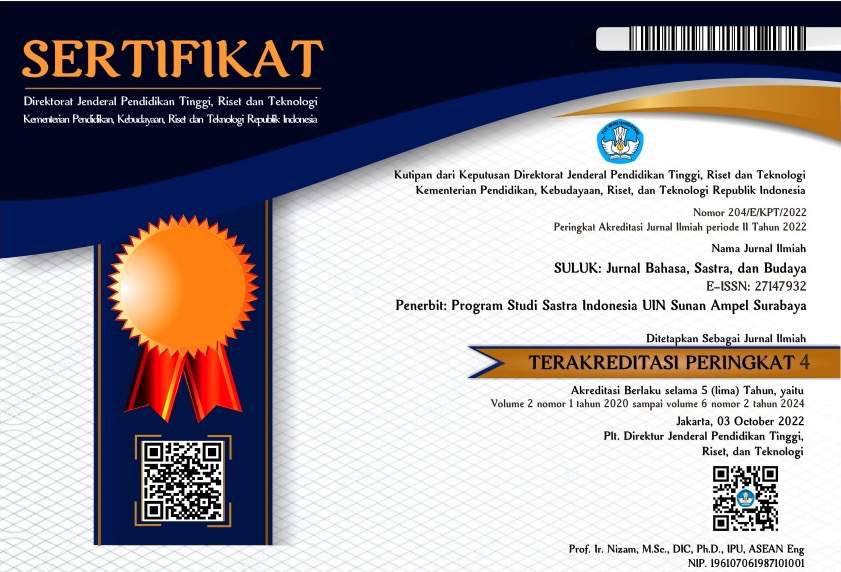Kesenian Arsitektur Islam: Alun-alun Kabupaten Gresik Pasca Renovasi
DOI:
https://doi.org/10.15642/suluk.2020.2.1.37-43Keywords:
Gresik Square, Islamic Arts Architecture, Cultural Heritage, Gresik CityAbstract
This study aims to determine the Islamic art architecture used in the Gresik Square building after renovation in 2016. This study uses qualitative research methods based on literature studies and field studies. Literature studies in this study use a journal reference written by Fikriani, Aulia (2010) entitled “Arsitektur Islam: Seni Ruang dalam Peradaban Islam” and a thesis written by Azzahra, Nofianda Fatimah (2018) entitled Konflik Pemanfaatan Ruang Publik Kota. Furthermore, the field data sources in this study uses (1) Interviews obtained from the speaker, Mr. Kris Aji, as historian and cultural observer of Gresik, (2) Observation, and (3) Documentation of the Gresik Square building after renovation. The results of this study are the Islamic architectural art used in the Gresik Square building after renovation including (1) Transfiguration of the hallway structure on the ground floor, (2) Transfiguration or ambiguity of function in open spaces decorated with date palm trees, and (3) Ornamentation with Islamic feature and style used on the second floor of the Gresik Square building fences. Overall, it can be seen that, the Gresik Square building after renovation using Islamic art architecture is used as an affirmation of Gresik's identity as an Islamic city or santri city.
Downloads
References
Ashadi. 2017. Alun-Alun Kota Jawa. Jakarta: UMJ Press.
Aufa, Naimatul. 2010. “Tipologi Ruang dan Wujud Arsitektur Masjid Tradisional Kalimantan Selatan”. Journal of Islamic Architecture, 1 (2), 53-59.
Azzahra, Nofianda Fatimah. 2018. "Konflik Pemanfaatan Ruang Publik Kota (Studi pada konflik Pemerintah Daerah dengan Masyarakat terhadap Perubahan Alun-alun Kota Gresik menjadi Islamic Center di Kabupaten Gresik)". Skripsi. Prodi Ilmu Pemerintahan, Universitas Muhammadiyah Malang.
Bogdan dan Taylor. 1996. Metodologi Penelitian Kualitatif. Bandung: PT. Remaja Rosda.
Dinas Komunikasi dan Informatika Kabupaten Gresik. 2017. Profil Kabupaten Gresik 2017. Gresik: Dinas Komunikasi dan Informatika Kabupaten Gresik.
el Firdausy, Syarifah Wardah, dkk. 2020. “Kiprah Syaikh Maulana Malik Ibrahim Pada Islamisasi Gresik Abad Ke-14 M Dalam Babad Gresik I”. SULUK: Jurnal Bahasa, Sastra, Dan Budaya 1 (1), 1-10. http://jurnalfahum.uinsby.ac.id/index.php/Suluk/article/view/262.
Fikriani, Aulia. 2010. “Arsitektur Islam: Seni Ruang dalam Peradaban Islam”. Jurnal el-Harakah. 12 (3), 202-204.
Handinoto. 1992. “Alun-Alun Sebagai Identitas Kota Jawa, Dulu dan Sekarang”. Jurnal Dimensi 18 (September), 4-6.
Hilmiyah, Dewi Roihatul. 2017. "Pelabuhan Gresik Sebagai Proses Perdagangan dan Islamisasi Abad XV-XVI M". Skripsi. Fakultas Adab dan Humaniora, UIN Sunan Ampel Surabaya.
Nugroho, Adi. 2020. “Pesona Keindahan Wisata Alun-Alun Kota”. https://ihategreenjello.com/pesona-keindahan-wisata-alun-alun-kota21/ [18 Juni 2020].
Rusdianti, Evi. 2019. "Kehidupan Sosial Ekonomi Pedagang Kaki Lima Pasca Renovasi Alun-alun Gresik". Skripsi. Prodi Ilmu Sosial, Fakultas Ilmu Sosial dan Politik, UIN Sunan Ampel Surabaya.
Putrie, Yulia Eka dan Atik Hosiah. 2012. “Keindahan dan Ornamentasi dalam Perspektif Arsitektur Islam.” Journal of Islamic Architecture. 2 (1), 46-51.
Downloads
Published
How to Cite
Issue
Section
License
Copyright (c) 2020 Abdul Wafi, Farida Novita Rahmah, Fadlilah Novia Rahmah

This work is licensed under a Creative Commons Attribution-NonCommercial-ShareAlike 4.0 International License.
- Authors retain copyright and grant the journal right of first publication with the work simultaneously licensed under a Creative Commons Attribution ShareAlike License that allows others to share the work with an acknowledgment of the work's authorship and initial publication in this journal.
- Authors are able to enter into separate, additional contractual arrangements for the non-exclusive distribution of the journal's published version of the work (e.g., post it to an institutional repository or publish it in a book), with an acknowledgment of its initial publication in this journal.
- Authors are permitted and encouraged to post their work online (e.g., in institutional repositories, pre-print sites, or on their website) prior to and during the submission process, as it can lead to productive exchanges, as well as earlier and greater dissemination of published work.








